26 Sept-17 Oct 2013. For the first time in over a year I’m actually writing about a place while we are still there. It won’t last long, since we leave tomorrow, but for now I’m up-to-date.
We rented an apartment in BA, for the grand sum of $35 per night, in Recoleta, one of the more up-market regions of the city, though the apartment is somewhat faded. It has seen better days, but serves us well in all our basic needs. Good thing. As per the previous post, we’ve spent a lot of time in here, organizing the rest of our travels around Argentina, Uruguay and Chile. In between we’ve managed to travel all over the city to see beautiful buildings, Sunday ferias (neighbourhood street fairs), parks and reserves, a little tango dancing, a river delta and the world’s most extraordinary cemetery.
I’ve always, wrongly, called in Bwenos Aries, as in Aries the Ram. It’s actually closer to Bwenos Eye-rez. It’s a very cosmopolitan, European city, with wide boulevards, beautiful old French style buildings, many parks, and a population almost exclusively of European descent. Fashion and cafes are rampant. It’s known as the Paris of South America and I can see why, but, um . . . . .it’s no Paris, one of my favourite cities in the world. Not to say BA is awful. Far from it. As cities go it’s pretty good, and has been good to us. People have been helpful and friendly, there’s good infrastructure, and we’ve seen and done some wonderful things.
I don’t think I can convey how long it took us to get “Sube” cards to travel by public transport around the city. They are like London’s “Oyster” card, or Montreal’s “Opus” card, allowing you to use the one card for travel on all public transport. Each place we asked we were told to go somewhere different. Many times. They are not available at the subway stations. You need exact change (coins only) for the bus fare and it varies with how many stops you are going, and no one seems to want to give out coins in change so we really wanted these cards. Finally we found the Sube head office and waited in line for about 30 minutes, presented our passports and got our cards. After we’d used the 20 pesos we’d charged them up with it was then another merry-go-round to top them up but we finally did it. Same story with getting a SIM card for the phone – not available anywhere except at the head office of the service provider.
Everyone warned us about BA. Even before we left Vancouver a friend told us a story about a friend of hers who had been held up at gunpoint here. The taxi driver from the airport warned us, the apartment agent warned us. Over and over we were getting the message it’s not safe here. Well we’ve been safe. So far. Don’t want to tempt fate. It has made us reluctant to go out much at night, though when we have it’s been fine, and it has made us be more vigilant with our belongings, and reluctant to walk on empty streets. Always aware of surroundings. Daypacks and camera strapped on tight. And yet, a short piece from Don about our daily life here: For my birthday dinner this evening we stopped on the way home at our local fish market to get a salmon fillet, some fresh asparagus from our local fruit and vegetable store, and some fresh hand-made ravioli with a spinach filling from the pasta shop. To go with all that a bottle of an excellent 2011 Argentinian Sauvignon Blanc from our corner grocery store for the equivalent of US$12. Heaven! It’s very civilized. It’s very western, very cosmopolitan, and in places very sophisticated.
Some (not so typical) BA street scenes
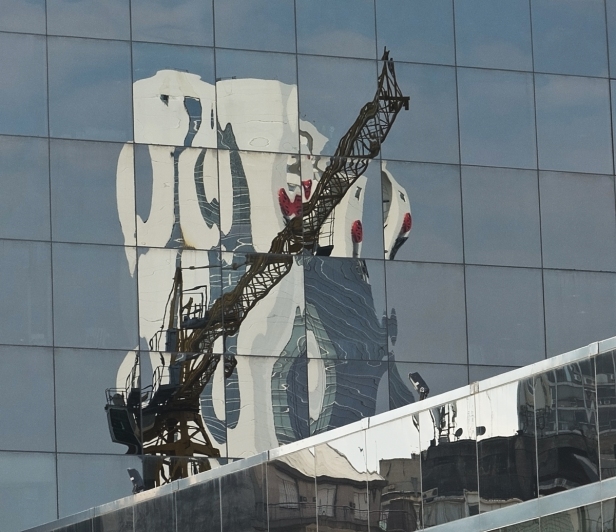

Floralis Genérica, a gift to the city by the architect Eduardo Catalano. Huge and beautiful, sitting in a reflecting pool in a large park. Its petals can open and close though according to Wiki the mechanism is disabled. No matter, open to the sun is just fine.
I first visited La Recoleta Cemetery over thirty years ago, and never forgot it, and I’ve never seen anything like it since: a whole village of mausoleums. It’s quite extraordinary. Streets and streets of little buildings housing the dead. Family mausoleums laid out like a village. All different architectural styles. The burial place of whole families, of presidents, writers, actors, soldiers, politicians, Nobel Prize winners, and Eva Peron. Each building houses the remains of many. Some are well maintained, some sadly neglected.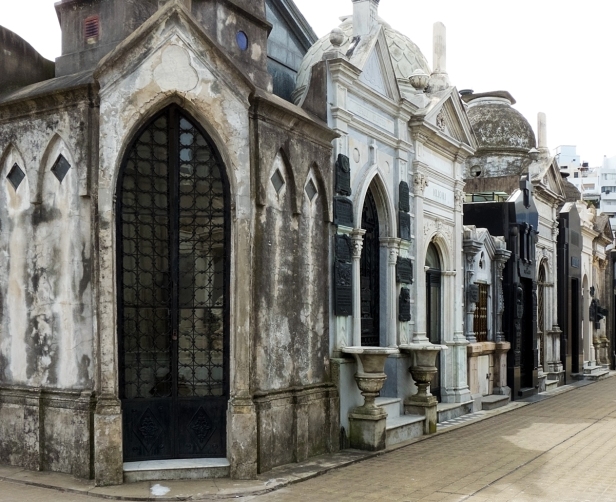


A peek inside, though this is one of very few where that is possible
Cemetery cat. Be afraid. Be very afraid . . . . .
Of course we went to the Sunday market at San Telmo, a charming barrio (neighbourhood) of cobblestone streets dating back to the 1800’s, and full of antique stores. It’s listed as one of the top places to see in BA and on Sundays it comes alive with street stalls and musicians. Some people writing Tripadvisor reviews complain that it’s touristy and there are no longer any real antiques there. They may be right. Whatever. It was lively and colourful and alive and full of incredibly creative crafts for sale, and musicians, and tango dancers, and fun. We loved it.








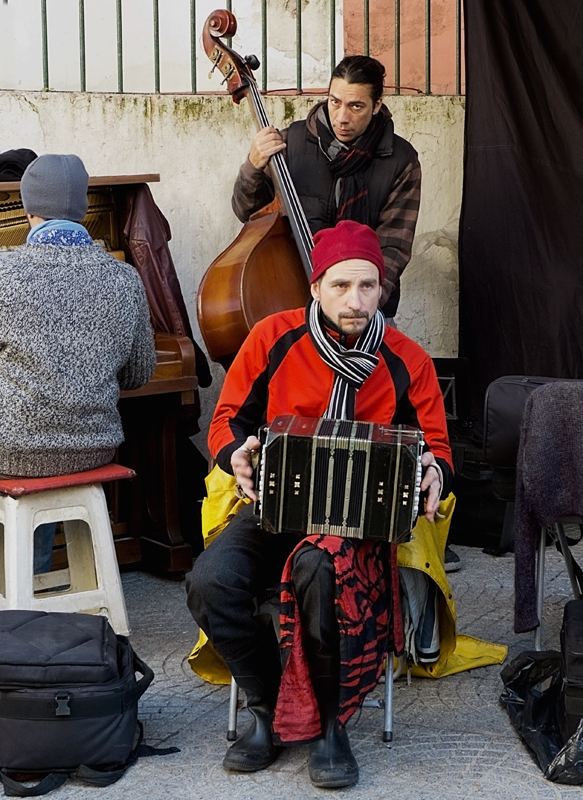
We’d decided we’d had enough fun for the day and set off walking back to the underground to go home. After two or three blocks Don realized we were going the wrong way. What serendipity that turned out to be. We continued around the block to change directions. After a while I could hear drumming. I immediately quickened my steps of course, walking towards the noise. I wanted to know what it was. This is what we came across: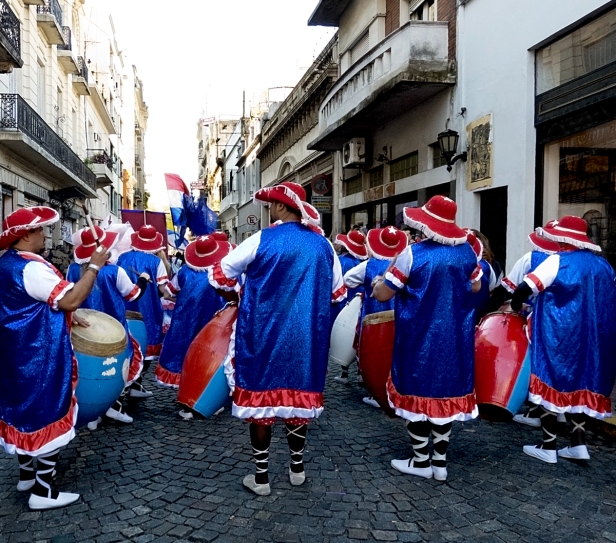
about sixteen men and one boy
drumming and marching down one of the narrow streets. We walked until we got in front of them. Three young boys waving flags high in the sky were leading them,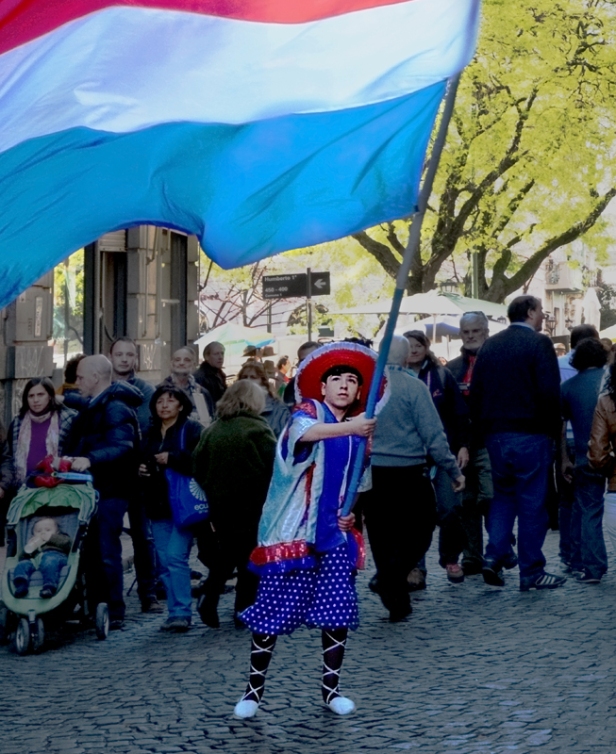
and in between the flag bearers and the drummers were the dancers,
all of them drumming and dancing all the way down the street to the town square. What a hoot! And huge props to those girls for being able to dance, really dance, on cobblestones, in those high heels! Tyra would be proud.
We couldn’t find out anything about them.
From all I’ve read I think the nightlife in BA is extraordinary – bars and dance halls and concerts and shows – and it starts late and goes later, every night. Certainly each time we were out late the streets were crowded. But we’re not nightlife people so some may think we have not had a true taste of this vibrant city, and they’re probably right. But we have gone wild and had wine with dinner more than once, and even actually tried the steak. We’re generally not red meat eaters either, but since Argentina has the best beef in the world (with the possible exception of Kobe beef) we thought we’d better try it. It was melt-in-the-mouth delicious.
There’s a fashion house, Tramando, just down the street from us that we’ve walked by just about every day, and each time I admired the clothes in the window. One day they were changing the window display and we got talking to one of the designers who was checking his work from the street. He invited us to an evening soiree at the store! So chic!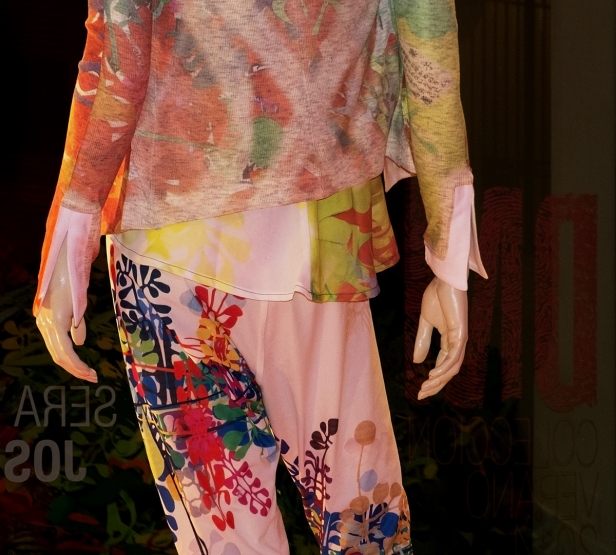

Meanwhile, wandering the streets we came across these two guards from the Regimiento de Patricios
and this display of the latest in men’s avant-garde fashion. Not that we’ve actually seen any men dressed like this.
A milonga is a public dance where people go to dance the tango, though some have branched out to include a little salsa and jive. They are all over BA and are held both in the afternoon and late in the evening. They almost always include a class beforehand. We weren’t up for a class. Um how do I put this politely? – Don is not a natural dancer, and I love to dance but can’t follow choreography to save my life. So we dropped in on an afternoon milonga to see what it was all about. So sweet. An afternoon tea social, only there was more wine and coffee being drunk than tea I suspect. We sat and watched. Mostly the men and women sat separately. When the music started, somehow by osmosis each found a partner and immediately they were dancing a very sedate cheek-to-cheek tango. Whether or not they knew each other before hand we couldn’t tell. We could tell they were enjoying themselves immensely in a very kind and gentle way. We left feeling completely openhearted.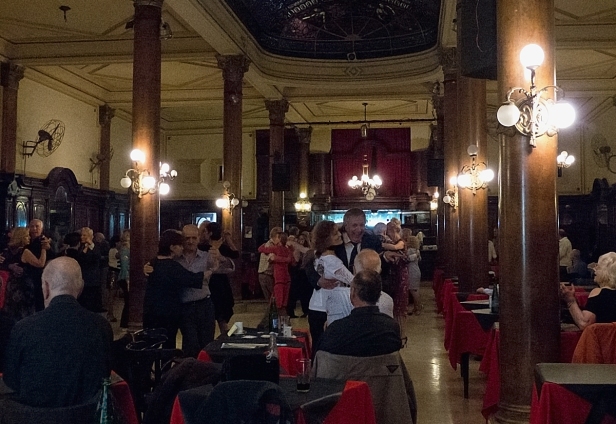
That evening we went to a tango performance, which was an entirely different animal. Two fabulous musicians, two equally fabulous singers, and S.E.X. on the dance floor. Apparently the tango originated in the brothels of Argentina. It has a raw uninhibited sensuality and sexuality; it’s foreplay as a dance, and the performance was superb.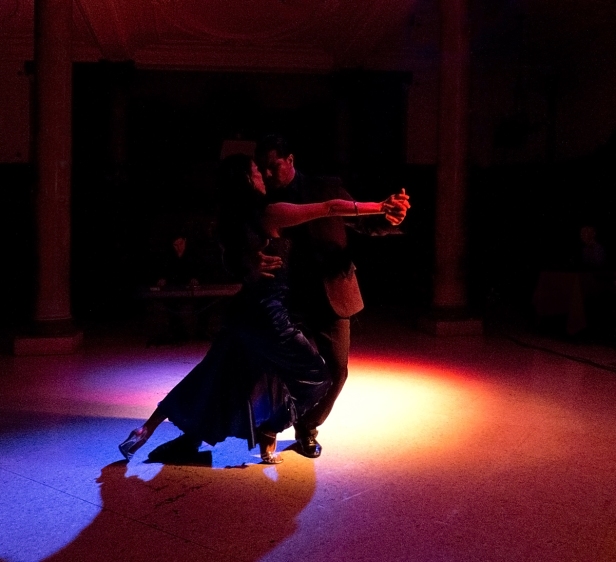
Moving on from the Tango I’ll finish this post with a word about maté. It’s an infusion of this caffeine-rich herb, which everyone drinks in great quantities, maybe even more than coffee. It’s drunk through a metal straw with tiny holes in the bottom acting as a sieve. What intrigued us most was the great abundance and enormous variety of handcrafted maté cups available at all the markets. They are usually made from gourds which we saw covered in intricately worked silver, a cows hoof, hand woven fabric, painted designs, and our personal favourite, the skin of a single cojone from a very sad bull.

Next post: A gaucho market, an ecological reserve right in the city, dog walkers (yes dog walkers) and the most colourful barrio of BA.
All words and images by Alison Louise Armstrong unless otherwise noted.
© Alison Louise Armstrong and Adventures in Wonderland – a pilgrimage of the heart, 2010-2015.

Serendipitous, indeed, that you got turned around a bit — you were rewarded with double the fun!
As always, my eyes drink in your photographs (you really should pitch your work to National Geographic) and I pore over each picture, taking in the color, the facial expressions, and body language.
Funny thing about the mate’ cups — our dentist recommends them for coffee/tea drinkers. Apparently by using a straw a person cuts way down on tooth stains that would otherwise occur.
LikeLike
Thank you so much. I don’t think Nat Geo would be interested tho I may be wrong. They have a travel photo of the day thing on their website and say essentially no Photoshop. I unashamedly do a lot of work in Photoshop to make my photos look the best I can. I’m not a purist, at all! – it’s the story that’s most important to me and if removing a person or a piece of garbage, or reversing the picture, or fading the background, or reducing the overblown highlights, enhances the story and makes the central point of the photo more accessible to the viewer then I’m all for it. Nat Geo not so much apparently.
Interesting about the mate straws. Maybe I should get one – I travel with a cup anyway.
LikeLike
Further to mate — in our little village of Courtenay there is a Tea store and you can buy yerba mate by the bag along with the gourds and straws! I am hooked on yerba mate tea.
LikeLike
I should try it! We see people drinking it all the time but haven’t even tried it. Well there’s still time. It’s probably a healthier way to get a caffeine hit than coffee.
LikeLike
I love that you included pictures of the cemetery. There’s one in Paris a lot like the one you found in Buenos Aires, and I spent a wonderful afternoon walking down its streets. I don’t think I’d hang out in one at night, but by day old cemeteries are one of the most peaceful and architecturally beautiful places I know.
LikeLike
I didn’t know there was a cemetery like that in Paris! – must check it out next time we are there. Yes, some beautiful architecture. We don’t usually go looking for cemeteries but this one is definitely special.
LikeLike
What a fun alive place. I could get used to visiting there. Love the photos. xoxo
LikeLike
It really is a good place. No, it’s not Paris, but it’s a very alive vibrant city and we’ve enjoyed our time here. Glad you like it – next post you get to visit some more 🙂
xoxox
LikeLike
I like those wirey women and their purses. And the tree woman and the masked man. Clever crafting always makes my day. Thanks for capturing those!
LikeLike
Wot! You didn’t like the bull’s cajone? That’s clever crafting too! 🙂
Clever crafting always makes my day too. It’s one of the reasons I love the markets so much. I’m always thrilled by people’s ingenuity and creativity, and the beauty they produce. Next post a guy who makes beautiful boxes from orange peel – amazing.
What masked man?
LikeLike
The bull’s cajone, yes! It brought back a memory from just outside of Sacramento, where we met a lovely old guy in his antique store, got to know him over a period of a couple of weeks, and I ended up bringing home one of his novels to edit for him. I bartered the job and really wanted him to give me this dried bull’s penis — it was as long as a walking cane and dried up like rough leather. But he wouldn’t part with it, and instead I got a beautiful antique navy diving knife for Ian, one that screwed into its own thick brass sheath. I wanted that “walking stick” though!
By “masked man”, I was referring to the photo right under the tree woman.
LikeLike
That must have been some “walking stick”! 🙂 Great story!
The masked man is a puppet made from foam.
LikeLike
Years ago I had some friends from Buenos Aires, and the way they were talking on and on about their city made me so curious about it.
I am so happy you are now getting to share with us this beautiful and interesting city and your stories are also going to give it even more flavour 🙂
Safe trip to your next destination Alison
LikeLike
Thanks Anyes. Yes, it is a beautiful city, very European, very alive and vibrant. It doesn’t feel at all like we’re in South America.
Our next destination is Iguazu Falls – tomorrow!
LikeLike
Okay, Buenos Aires goes on the bucket list, too! What a great place to visit and your pictures were marvelous. My favorite was the picture of the elderly man and woman dancing the tango – how I hope to be dancing when we reach that age!
LikeLike
Thanks so much. Yes, definitely worth a visit – very vibrant alive city. Those tango dancers shuffle around at the San Telmo market and have been there for years. You can see they no longer have to think about the steps. I think they used to do tango that was a bit more dramatic in their youth, but for now they keep at in the way they can – so charming. Don found a photo of them in a BBC (I think BBC) article that’s a few years old. I imagine they’ll be there for a few more years to come.
LikeLike
What a lovely post of a city I love. However, it has changed from when I was most taken by it. It is dangerous so your cautions are well taken. Not as lively as before. And certainly not as cheap as before either. Your photos are delightful!!!
LikeLike
Thanks Lidia, glad you enjoyed it, and thanks re the photos – so many interesting subjects! I suppose all cities change. I remember falling in love with San Francisco in 1974, and then going back 4 or 5 years later and being quite disappointed. Still, the BA we found was pretty lively, but no, not cheap.
LikeLike
LOVE This post and love Beautiful Buenos Aires!!
LikeLike
Thanks Cindy 🙂 Yes, beautiful Buenos Aires! Off to Iguazu today! Excited 🙂
LikeLike
Great photos! And a happy belated birthday to Don. What better way to celebrate!
LikeLike
Thanks Angeline. There’s much to photograph here. I aways have trouble choosing photographs!
LikeLike
Fascinating review of BA,..you really brought it to life�I felt like I was there with you�thank you for sharing the adventure..love eva�glad you are safe�
From: Adventures in Wonderland Reply-To: Adventures in Wonderland Date: Wednesday, 16 October, 2013 12:17 PM To: owner Subject: [New post] Argentina � Part 1: Buenos Aires
WordPress.com Alison posted: “26 Sept-17 Oct 2013. For the first time in over a year I�m actually writing about a place while we are still there. It won�t last long, since we leave tomorrow, but for now I�m up-to-date. We rented an apartment in BA, for the grand sum of $35 per nigh”
LikeLike
Hi Eva, how are you? Thanks, and you’re welcome – I’m glad you enjoyed the post. BA is a great city.
love from us
xoxox
LikeLike
You’re probably made more welcome because you’re not British, I hear we’re not too popular there.
LikeLike
I’m not so sure about that. I read a fairly recent article about how they love all things British here despite the Falklands war. OTOH I think I saw protesting about the Malvinas. People have no way to know we’re not British and there’s lots of British stores here – for the polo clothes dontcha know!
LikeLike
That is one big cajone! Also, I loved the scruffy cat and would love to visit the cemetery. Great blog as always Alison and Don.
LikeLike
Thanks Curt. I guess that was one big bull! 🙂
LikeLike
Aah thank you for letting me experience the city through your eyes! Buenos Aires is one of the places I really really reeaaallyy want to spend some time in and your writing reminded me just why that is.
LikeLike
Thanks. Yeah, it’s a good city. Come spend some time here!
LikeLike
I will as soon as possible! 🙂
LikeLike
Love this, really makes me want to go back there (sniffle).
I wandered around at all hours, and although I stayed alert, I never felt threatened. Maybe I was just naive….
LikeLike
Maybe you’ll get back one day.
We never felt threatened either, though we sure stayed alert and didn’t do stupid stuff like walk around with our bags wide open. I’m not convinced BA is any worse than most other big cities.
LikeLike
I’m not either. I also remember that one travel guide I looked at said that there were dogs running loose on the streets, and that there was dog poo all over the streets with cockroaches and other bugs crawling on it. And to be sure to wash/wipe your shoes carefully after going out. Seriously! I saw lots of dogs but with dog walkers, but nothing even close to the rampant filth that guidebook described….
LikeLike
True about the dog poo, not about the dogs running loose or the cockroaches. Lots of dog walkers – in Recoleta anyway, but we went all over the city by bus and by walking and never saw anything like what you’ve described. I’ve seen much grubbier cities than BA. *Much* grubbier. India anyone? 🙂 Poor old India, I love it, but really they do need to do something about the garbage in the streets . . . . .
LikeLike
nice! very lovely tour and happy belated birthday, Don – fabulous place to celebrate. your photographs offer an eclectic type culture. colorful displays mixed with traditional scenery. i love the Mate mug that looks like a animal hoof – how smart and sounds delicious. was it? thanks for sharing and thankfully, in safekeeping while visiting. ♥
LikeLike
Thanks Sun. We didn’t actually try mate! So silly. Must try it when we’re back in BA in a few days. We’re currently at Iguazu Falls. Those mate mugs come with just about every kind of outside decoration you could imagine. I thought the cows hoof was pretty ingenious.
LikeLike
BA looks phenomenal! I just love the picture of the lady flower tree 🙂 your photos always sell the destination you are visiting Alison. That is what I adore about your blog ~ Lakshmi x
LikeLike
Thank you so much Lakshmi. BA is pretty amazing as far as big cities go, so there was lots that’s interesting to photograph – I guess that helps 🙂
Hope you’re having a fab time in India! (Of course you are – I know how much you love it there.)
xoxox
LikeLike
I certainly am Alison thank you so much! I am back at the Sripuram Ashram with Amma. No Ross this time…Padma and I miss him and how we teased him a little about his mosquito phobia 🙂 Lakshmi x
LikeLike
Beautiful photos and descriptions. Tango takes years to master. The porteños make it look easy. My wife, who is a tango dancer, has been to BA several times, to get better at tango and to buy tango shoes.
LikeLike
Thanks Frank. Glad you enjoyed it. I think Porteños are born with tango shoes on their feet lol! And I can’t imagine getting the best tango shoes anywhere but in BA. It’s also a fabulous city. I bet your wife loves it.
We saw some good dancers on the street, but the two couples we saw in the performance we went to were just superb, and we went to one of the smaller shows. We thought about going to one of the big splashy tourist shows, and I kind of wish we had, but at the lowest price of $120 each it was a bit steep. One show, like the one we went to had only 2 couples dancing, and was $135!
I must say I learned to appreciate tango in a whole new way.
LikeLike
Fantastic!
LikeLike
Thanks Jane 🙂
LikeLike
As usual, an amazing and superb encounter with another distant land we’re aching to see.
Your photos: incredible. The snap of the couple dancing cheek to cheek made me well up. Wonderful.
I would absolutely love to experience a live tango show, maté and some of that famous beef.
It all sounds just incredible ~ Heading over to Pt 2 now!
~Andrea<3
LikeLike
Thank you so much Andrea. We finally tried mate yesterday. It is very bitter. Definitely an acquired taste, especially for sweet-tooth me. The dancing couple have been dancing the tango at the San Telmo market every Sunday for many years. Aren’t they wonderful?!
BTW I’ve been loving your series on HK – it’s very different from when I was there in 1980!
LikeLike
Alison and Don, You have definitely rekindled my interest in BA. It’s been on and off our list for years, but it sounds fascinating. It is truly a city with its own soul. Happy birthday Don, your birthday feast sounds delicious!. And I never really knew what maté was. Does the flavor compare to anything else? ~Terri
LikeLike
Thank you Terri, and thanks from Don for the b’day wishes. Mate is extremely bitter – one try was enough for both of us. Definitely an acquired taste. BA is definitely worth a visit.
Alison
LikeLike
oh the fabulous places that you see! the mausoleums look fascinating. and i agree about the serendipity thing, sometimes, you get a little lost then stumble upon something wonderful. and you’re so lucky to have seen a real Tango performance!! that’s awesome.
and i know it’s super late, but happy birthday to Don 🙂
LikeLike
Thanks kz, and thanks from Don too. He doesn’t look any older lol.
Definitely BA is a great city. I’m glad we got to spend some time there. And the tango performance was swoon-worthy!
LikeLike
Very Nice ! Love this post, and your pictures. I had the pleasure of staying in Buenos Aires for 6 weeks, February & March of 2012, and I loved the city. My base was San Telmo, where i see you enjoyed the Sunday market.
The extraordinary old tombs at Recoletta were another favourite of mine. B.A is actually where i started blogging. You may enjoy the pictures (and fairly silly commentary) in this post amusing. http://arranqhenderson.com/2012/04/02/l1020087/
Either way, thanks for your visits
and Many thanks for your nice comments on my blog,
I hope you do make it to Ireland some time. Please look me up if or when you do, we’d love to have you on one of our walking tours.
very best regards – Arran.
LikeLike
Thanks so much Arran. We loved BA. It’s a great city. And I enjoyed your piece on Recoletta. I hope we make it to Ireland too!
LikeLike
Fun post. My son was warned by his study abroad organizers about the many ways people will try to cheat you. Like don’t give a taxi driver a big bill, because he will switch it, then give back a counterfeit one, telling you he can’t accept it because it’s counterfeit. They told him which neighborhoods to stay out of, too. And I know he listened and was cautious, while still living fully there, because the student who came after him, in their three day overlap, got lost, mugged, and cheated of a big bill by a taxi driver. That young man had gotten the same warnings that Eli had gotten, but laughed them off and paid the price. I am glad that your experiences have been positive ones!
LikeLike
We really enjoyed Buenos Aires, but we too were cautious. I guess that other student learned some good life lessons the hard way. Well hopefully he learned. We’re off to Quito soon and are hearing the same stories about how dangerous it is. I think you just need to really keep your wits about you and listen when you’re cautioned not to go somewhere. South America has all been positive so far except for dealing with altitude, and a bout each of food poisoning – but that comes with the territory.
LikeLike
It was the altitude sickness that got me–fever and shortness of breath. I hope it wasn’t that bad for you.
LikeLike
It’s been a bit of a struggle for us, but mainly because we’ve made these ridiculous massive jumps, from 2400 to 5000metres in the space of a few hours, and then coming back to Puno for a festival from Lima – sea level to 3800 metres in a couple of hours. It’s draining. No fevers, but shortness of breath, spacey and no stamina. But fortunately nothing major, just annoying.
LikeLike
Great description of Buenos Aires! I’m glad you enjoyed this city, it’s so incredible with so much to see… and our beef really is the best of the world!
LikeLiked by 1 person
Thanks so much Paloma. I’m glad you enjoyed it. We loved BA.
Alison
LikeLiked by 1 person
Loved reading this! Ten years on and some things haven’t changed at all! They are still drumming on the streets (although sadly haven’t seen anyone in those extraordinary get-ups!) and the Sube card is still difficult. It is a fabulous city though!
LikeLiked by 1 person
Thank you so much. I’m glad you enjoyed it. We really liked BA, and never felt unsafe. We were there for 3 weeks. A lot of that time was spent on planning forward travel, but we still managed to get out a fair bit to see the city. I agree, it *is* a fabulous city.
Alison
LikeLike